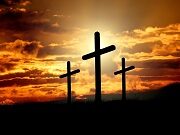The Sermon On The Mount takes up 3 of the 28 chapters in Matthew's Gospel. Obviously, Matthew thought it was important. Since he was Jewish, much of what Jesus said in that event was earth-shaking for Matthew. Since Matthew was a tax collector - hated by pretty much everyone, especially other Jews - The Sermon On The Mount was undoubtedly amazingly good news for him. Jesus turned the whole Jewish world on its head with His words.

Jesus begins with nine statements, all beginning with "Blessed are ...". Most of them are pretty far from the kinds of people the Jewish leaders considered blessed.
Not long after that, Jesus keeps repeating "You have heard that it was said ..." in different contexts. Again, these are statements that just blow away what the Jewish people were taught for generation after generation.
Later, what Christians know as The Lord's Prayer is introduced. Once again - mind-blowing to the Jewish listeners.
After that - some warnings and parables.
All of it ends with this reaction from those who heard Jesus speak.
Mt 7:28 When Jesus had finished saying these things, the crowds were amazed at his teaching, 29 because he taught as one who had authority, and not as their teachers of the law.
More bad news for the Jewish leaders. But at the same time, good news for the Jewish people. But what about us? We read these statements today. We know they're collectively called The Sermon On The Mount. But are they as mind-blowing and earth-shaking today as they were nearly two thousand years ago?
What was / is The Sermon On The Mount?
I found this quote, while doing research for this topic:
The Sermon on the Mount is probably the best-known part of the teaching of Jesus, though arguably it is the least understood, and certainly it is the least obeyed. It is the nearest thing to a manifesto that he ever uttered, for it is his own description of what he wanted his followers to be and to do. To my mind no two words sum up its intention better, or indicate more clearly its challenge to the modern world, than the expression ‘Christian counter-culture’. 1Stott, J. R. W., & Stott, J. R. W. (1985). The message of the Sermon on the mount (Matthew 5-7): Christian counter-culture (pp. 14–15). Leicester; Downers Grove, IL: InterVarsity Press.
Let's look at some of the things John Stott said in that short excerpt from his book.
Christian counter-culture
Let's look at the last one first. Stott called the Sermon On The Mount a challenge to be part of a Christian counter-culture. You may not realize that "counter-culture" wasn't even a term until the mid 1960's. Here's how dictionary.com refers to its origins.
counterculture: A protest movement by American youth that arose in the late 1960s and faded during the late 1970s. According to some, young people in the United States were forming a culture of their own, opposed to the culture of Middle America. ( See hippies and Woodstock.)
If you're not familiar with hippies and Woodstock, I leave it for you to Google them and find out more. I will say though - it had nothing to do with Christianity.
These days, counter-culture to some techie people would be more like rejecting email, because that's what the "old people" use.
I doubt that a huge number of people today would refer to Christianity as counter-cultural. In fact, being in what's called a post-Christian era, more people are likely to view Christianity as the old way - much like young people don't use email, Facebook, and countless other "old" technologies.
The question is - why not? Christianity should be very much a counter-culture. The fact that it isn't, I believe, is more related to how Christianity is practiced than it is to what Christianity is really about. I'm talking about the Christianity of Jesus - not the Christianity of man. Not the European model, where people are more into following The Force, as in Star Wars, or being a "none". And not the Christianity of America, where the so-called prosperity Gospel seems to have more followers than anything close to what Jesus actually spoke about.
Footnotes
- 1Stott, J. R. W., & Stott, J. R. W. (1985). The message of the Sermon on the mount (Matthew 5-7): Christian counter-culture (pp. 14–15). Leicester; Downers Grove, IL: InterVarsity Press.
Discover more from God versus religion
Subscribe to get the latest posts sent to your email.
